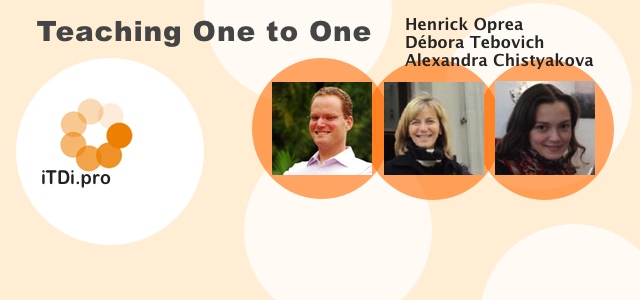
What Makes One-On-One Classes So Special?
– Henrick Oprea
After a long time teaching mainly groups, I’m now back in the position of having an equal number of private (or one-on-one) lessons. This certainly makes it easier for me to put things into perspective. It’s shed some new light on the differences between each kind of teaching, and also on what makes it so special for me as a teacher.
First of all, I’m a firm believer in personalisation and proper feedback for students. I also believe that the role the affective part plays in teaching is just as important as the role of the cognitive part as you can’t really have positive cognitive results if you’re unable to connect with your learners in the first place. When I’m teaching a group, I usually take advantage of the first classes to get to know my students as people and create some rapport with them. It makes it easier for them to trust me as a teacher and this allows me to demand a lot more from them.
In a one-on-one classroom, with only two people in the room, empathy is key. What I try as much as possible is putting myself in the shoes of the learners and really understand not only the reasons for their need to learn, but also their shortcomings and even traumas with their language learning experiences. I use the word traumas because so far I’ve chiefly worked with adults in one-on-one classes, and they’d already been through some learning experiences before they decided to try having private lessons. Such exchange and understanding of your learner has to be done from the very first time you two have the chance to talk. If you manage to pass this stage successfully, you’re bound to have loads of fun, learning and reflection.
In a one-on-one class, the teacher has to be prepared to cater for that learner in particular. This certainly means being prepared to change your lesson plan entirely if need be. Suppose your student works for a company that has decided – in a meeting right before the class – to send him or her abroad for a meeting, or that there’s a document that needs to be replied to urgently and your student asks for your help? You’ve got two options:
- Sure, I can help you with that as much as possible;
- Sorry, but that’s not what you’re paying me for.
I myself always take the first option. By making yourself available to help your student with something that truly is meaningful for him or her, you have the chance to create lots of learning opportunities that will stick. After all, they are the ones who have brought the material to class, they’ve got an interest in learning what’s there, which is likely to translate in easier retrieval of what you end up teaching them. In addition to helping them, you yourself may end up learning something new and that is likely to be useful in the future with other learners.
Another point to consider is how resourceful you ought to be as a teacher when you’re teaching one-on-one lessons. In a group, you’ve got different learners, each with his or her expectations, demands and worries. More often than not, they’ll end up having to adapt to one or two activities you’ve decided to do in a class simply because this activity caters best to other learners in the group. At the end of the day, you need to add variety to your classroom activities, but your ideas can be used and reused every now and then. When you’re teaching one student only, things are slightly different.
Each learner has his or her own shortcomings, and it is only by being truly aware of these that you’ll be able to help them achieve their goals. Such awareness can be taken to situations that are really extreme. For instance, I’ve never thought I’d have to teach someone who’s recovering from a stroke. Yet, I’ve been teaching a student for about 5 months now and I can’t tell you just how gratifying it is to witness his progress on a daily basis. This has meant a lot of work on my side, as I had to not only re-read much of what I’d read about it, but I also had to study new things on the development of the brain. Among the many benefits to me, it’s rekindled my interest in cognitive neuroscience and it has forced me to put into use many of the different techniques I’d learnt in my teaching career.
There are also the other (more regular) cases, the ones in which you’ll find yourself dealing with a top executive who needs to prepare for a presentation in English, or for a business trip. There are those who are just interested in learning the ropes of the language to be able to communicate on their next trip to Disney World. There are students who want you to use a course book, and students who despise the use of a course book. Each student is unique, and so should your teaching be. It takes the one-size-fits-all approach completely off the table.
Teaching one on one means being prepared to tackle all possible situations as they come, it means being on the top of your game at all times and being able to think on your feet. Oh, wait a minute…. This is what teaching itself entails. The main difference in a one on one class, then, is the fact that you’ll end up having to develop your bag of tricks a lot further and faster if you are to make things interesting each and every day. Most importantly, you’ll better understand the value that trust, empathy and affection have in learning after you have the chance to work with one-on-one classes.
Connect with Henrick and other iTDi Associates, Mentors, and Faculty by joining iTDi Community. Sign Up For A Free iTDi Account to create your profile and get immediate access to our social forums and trial lessons from our English For Teachers and Teacher Development courses.





